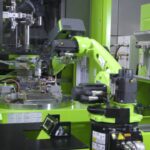In the ever-evolving world of technology, automation stands at the forefront of innovation, reshaping industries…

Hewlett-Packard (HP) has become synonymous with printing technology over the past few decades. The company’s journey from producing calculators to leading the global printing industry is one of constant innovation and adaptation. While HP’s personal computing devices and enterprise solutions have earned recognition, its advancements in printing technology stand as a testament to the company’s lasting influence.
Table of Contents
ToggleThe Evolution of HP Printing Solutions
HP’s printing division dates back to the 1980s when it first introduced the LaserJet printer, which quickly became a staple for businesses worldwide. The LaserJet revolutionized the way businesses and individuals printed documents, offering a faster, more efficient, and cost-effective alternative to dot matrix printers.
In the 1990s, HP continued to innovate by launching the DeskJet series, aimed at consumers who needed high-quality color printing at home. The HP DeskJet printer was among the first to offer affordable inkjet technology, making it accessible to a broader audience.
As the years passed, HP remained at the forefront of the printing industry by continuously enhancing the capabilities of its printers. The company introduced wireless printing solutions, enabling users to print documents from smartphones and tablets without the need for physical connections. HP also embraced cloud printing, which allowed users to send print jobs to HP printers from anywhere in the world.
HP’s Innovations in 3D Printing
In recent years, HP has expanded its printing expertise into the realm of 3D printing. The company introduced its HP Jet Fusion 3D printing technology, which is capable of producing high-quality, functional parts for industries ranging from aerospace to healthcare. HP’s 3D printers have been lauded for their speed, precision, and ability to produce complex designs with minimal waste, which makes them a valuable asset for businesses seeking to streamline their manufacturing processes.
The HP Metal Jet platform, which was launched to address the growing demand for 3D metal printing, further solidifies HP’s commitment to pushing the boundaries of printing technology. The Metal Jet technology offers high-volume production capabilities, making it an attractive option for industries looking to optimize their production capabilities with durable, lightweight metal parts.
HP’s Environmental Focus in Printing
One of the major concerns surrounding traditional printing is its environmental impact, particularly in terms of paper waste and ink usage. HP has been a leader in addressing these concerns, focusing on sustainable practices within its printing division.
The company’s HP Instant Ink program is a prime example of this initiative. The program allows customers to subscribe to a monthly ink delivery service that ensures they never run out of ink, while also reducing waste. Instead of throwing away empty cartridges, customers can return them to HP for recycling. This effort helps reduce waste and encourages responsible consumption.
Moreover, HP has made great strides in creating printers that use less energy and produce less waste. Many of its recent models are ENERGY STAR certified, meaning they meet stringent energy efficiency standards. In addition, HP has been utilizing sustainable materials in the construction of its printers, such as recycled plastics, to further minimize its environmental footprint.
The Future of Printing with HP
As technology continues to evolve, HP is committed to staying at the cutting edge of the printing industry. The company is investing heavily in innovations such as AI-driven print solutions, smart printing technologies, and the integration of printing into the Internet of Things (IoT). These advancements are transforming the way we think about printing in both home and office environments.
AI-driven printing, for example, allows printers to automatically optimize print quality, speed, and energy usage, without requiring manual input. The integration of cloud printing and remote management solutions is also transforming business operations, offering companies greater flexibility and convenience.
The future of 3D printing with HP looks even more promising, with the potential to revolutionize industries like automotive, healthcare, and aerospace. As HP continues to push the envelope with its innovations, it will likely lead the charge in the next generation of manufacturing technologies, making products faster, cheaper, and more customizable.
Conclusion
From its beginnings in the 1980s to its current position as a leader in printing and 3D technology, HP’s journey is a testament to the power of innovation. The company continues to set the standard for printing solutions, blending cutting-edge technology with sustainability. As it continues to evolve, HP’s role in shaping the future of printing will be critical, influencing everything from consumer products to industrial applications. Whether in home offices or large-scale manufacturing, HP’s advancements in printing will remain central to the tech industry’s growth for years to come.
Related Posts
-
JCCS Robotics: Innovating the Future of Automation and Technology
-
JLDQ.19.371.188F04: Guide to Codes in Technology and Manufacturing
The identifier "JLDQ.19.371.188F04" does not correspond to any widely recognized term, product, or system that…
-
Engel Amorphous: Advanced Technology for Superior Cooling Solutions
In the world of refrigeration and cooling technologies, Engel Amorphous has emerged as a notable…
-
Zompopos: Termite Queens and Their Role in Ecosystems
In the vast world of insects, zompopos—a term that often refers to a specific type…
-
Shared Zaps: The Future of Collaborative Automation
In the fast-paced world of technology and automation, new tools emerge constantly, promising to streamline…
-
What is DC97-16350U? Role and Significance in Washing Machines
In the world of appliance maintenance and repair, understanding model numbers and part identifiers is…





